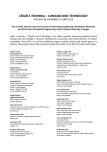Effect of the zinc phthalocyanine mediated photodynamic therapy on cytoskeletal apparatus of hela cells
Autoři:
Hosikova B 1; Binder S 1; Lenobel R 2; Malohlava J 1; Hosik J 1; Jiravova J 1; Malina L 1; Zapletalova J 1; Kolarova H 1
Působiště autorů:
Department of Medical Biophysics, Institute of Molecular and Translational Medicine, Faculty of Medicine and Dentistry, Palacky University, Olomouc, Czech Republic
1; Centre of the Region Hana for Biotechnological and Agricultural Research, Palacky University, Olomouc, Czech Republic
2
Vyšlo v časopise:
Lékař a technika - Clinician and Technology No. 2, 2019, 49, 41-45
Kategorie:
Původní práce
Souhrn
Photodynamic therapy is a very promising and constantly evolving diagnostic and therapeutic method that is used mainly for malignant and non-malignant tumors treatment. This study deals with the utilization of zinc photosensitizer (λmax ~ 660 nm) from the group of phthalocyanines in photodynamic therapy. The aim of this study is to evaluate in vitro effect of the 5 Jcm-2 zinc phthalocyanine photosensitizer-mediated photodynamic therapy in EC50 concentration (30 nM) on cytoskeletal apparatus of the tumor cell line—HeLa (cervical cancer cells). For the measurement, the tandem mass spectrometry, atomic force and fluorescent confocal microscopy techniques were used. The results showed, that compared to the control cells zinc-derivative mediated photodynamic therapy caused in HeLa cells significant change of the cell height and extensive cytoskeletal actin rearrangement although the levels of beta actin, gamma actin and F-actin did not change significantly. This is probably caused by decreased level of the ARPC2 actin-related protein which is responsible for actin polymerization. Its level decreased 24 hours after therapy by 56%. The cytoskeletal apparatus is one of the basic cellular structures that provides cell shape, cell division and the intracellular transport. After in vitro 5 Jcm-2 zinc derivative-mediated photodynamic therapy, the cervical carcinoma cells showed a significant damage of the cytoskeletal structure followed by changes of cell shape leading to cell death. Considering these results and low effective concentration (EC50 = 30 nM), the therapy used is potentially very promising antitumor treatment.
Klíčová slova:
Reactive oxygen species – photodynamic therapy – phthalocyanines – cytoskeletal apparatus
Zdroje
- Yin H, Ye X, Li Y, Niu Q, Wang C, Ma W. Evaluation of the effects of systemic photodynamic therapy in a rat model of acute myeloid leukemia. Journal of Photochemistry and Photobiology B: Biology. 2015 Dec;153:13-9.
- Mustafa FH, Jaafar MS. Comparison of wavelength-dependent penetration depths of lasers in different types of skin in photo-dynamic therapy. Indian Journal of Physics. 2013 Mar;87:203-9.
- Tsaytler PA, C O'Flaherty M, Sakharov DV, Krijgsveld J, Egmond MR. Immediate protein targets of photodynamic treatment in carcinoma cells. Journal of proteome research. 2008 Sep;7(9):3868-78.
- Qi D, Wang Q, Li H, Zhang T, Lan R, Kwong DW, et al. SILAC-based quantitative proteomics identified lysosome as a fast response target to PDT agent Gd-N induced oxidative stress in human ovarian cancer IGROV1 cells. Molecular BioSystems. 2015 Nov;11(11):3059-67.
- Stadtman ER. Protein oxidation and aging. Free radical research. 2006 Dec;40(12):1250-8.
- Liu JY, Li J, Yuan X, Wang WM, Xue JP. In vitro photodynamic activities of zinc(II) phthalocyanines substituted with pyridine moieties. Photodiagnosis and photodynamic therapy. 2016 Mar;13:341-3.
- Ongarora BG, Zhou Z, Okoth EA, Kolesnichenko I, Smith KM, Vicente MG. Synthesis, spectroscopic, and cellular properties of α-pegylated cis-A2B2- and A3B-types ZnPcs. Journal of porphyrins and phthalocyanines. 2014 Oct-Nov;18(10-11):1021-33.
- Cidlina A. Syntéza kationických ftalocyaninů. [Diploma thesis]: Charles University in Prague, Faculty of Pharmacy in Hradec Kralove. 2011. 72p.
- Petřík I. Analýza proteinových fosforylací proteomickými metodami. [Bachelor thesis]: Palacky University in Olomouc, Faculty of Science. 2013. 62p.
- Boersema PJ, Raijmakers R, Lemeer S, Mohammed S, Heck AJ. Multiplex peptide stable isotope dimethyl labeling for quanti-tative proteomics. Nature protocols. 2009 Mar;4(4):484-94.
- Radakovic-Fijan S, Rappersberger K, Tanew A, Hönigsmann H, Ortel B. Ultrastructural changes in PAM cells after photo-dynamic treatment with delta-aminolevulinic acid-induced porphyrins or photosan. The Journal of investigative dermatology. 1999 Mar;112(3):264-70.
- Agostinis P, Berg K, Cengel KA, Foster TH, Girotti AW, Gollnick SO, et al. Photodynamic therapy of cancer: an update. CA: a cancer journal for clinicians. 2011 Jul-Aug;61(4):250-81.
- Welch MD, Iwamatsu A, Mitchison TJ. Actin polymerization is induced by Arp2/3 protein complex at the surface of Listeria monocytogenes. Nature. 1997 Jan;385(6613):265-9.
- Pacheco-Soares C, Maftou-Costa M, DA Cunha Menezes Costa CG, DE Siqueira Silva AC, Moraes KC. Evaluation of photo-dynamic therapy in adhesion protein expression. Oncology letters.2014 Aug;8(2):714-8.
- Ferreira SD, Tedesco AC, Sousa G, Zângaro RA, Silva NS, Pacheco MT, et al. Analysis of mitochondria, endoplasmic reticulum and actin filaments after PDT with AlPcS(4). Lasers
in medical science. 2004 Jan;18(4):207-12. - Tsai T, Ji HT, Chiang PC, Chou RH, Chang WS, Chen CT. ALA-PDT results in phenotypic changes and decreased cellular invasion in surviving cancer cells. Lasers in surgery and medicine. 2009 Apr;41(4):305-15.
- Juarranz A, Villanueva A, Díaz V, Cañete M. Photodynamic effects of the cationic porphyrin, mesotetra(4N-methyl-pyridyl)porphine, on microtubules of HeLa cells. Journal of photochemistry and photobiology. B, Biology. 1995;27(1):47-
Štítky
BiomedicínaČlánek vyšel v časopise
Lékař a technika

2019 Číslo 2
Nejčtenější v tomto čísle
- Methods evaluating upper arm and forearm movement during a quiet stance
- Effect of the zinc phthalocyanine mediated photodynamic therapy on cytoskeletal apparatus of hela cells
- Wrist rehabilitation with manipulator to perform passive and active exercises
- A framework to assess mechanics of stump–socket interaction in transfemoral amputees
